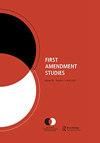占领华尔街论坛
Q2 Social Sciences
引用次数: 0
摘要
这个关于占领华尔街运动的论坛从几个角度探讨了2011年的现象。在第一篇文章“占领运动和第一修正案:一个困境”中,唐纳德·菲什曼对“言论加行为”问题的理论和法律背景进行了讨论。“占领华尔街运动”(Occupy Wall Street Movement)及其在全国各地的附属抗议活动,已经提出了重要的第一修正案问题,即利用营地来表达核心政治言论的新颖性。无论是民权运动的大规模抗议活动,还是20世纪60年代的反越南战争活动,都没有利用在公共空间上持续、半永久性扎营的策略。从2011年开始,长期使用营地的人与政府声称对公共安全和健康存在重大危险的说法之间出现了紧张关系。本文考察了在象征性言论下的判例法,以及围绕在第一修正案理论下使用营地作为政治鼓动的独特问题。在第二篇文章“在公共场所睡觉的梦想:占领华尔街运动和睡眠作为象征性表达”中,朱丽叶·迪伊(Juliet Dee)研究了抗议者起诉城市管理部门和警察部门侵犯其第一修正案的言论自由和集会自由的诉讼结果。尽管纽约、费城、华盛顿特区和芝加哥的法官做出了有利于市政当局或警察局的裁决,但洛杉矶和加州奥克兰的抗议者与市政府达成了庭外和解。然而,占领华尔街运动的真正遗产在于,它不仅在白天集会,而且在夜间集会的权利上“挑战了极限”,在一些城市,抗议者获得了搭帐篷和过夜的许可。在第三篇文章“未平方的广场或抗议和当代公众”中,苏珊·德鲁克和加里·甘珀特首先考虑了阿拉伯之春对占领华尔街运动的影响。然后,他们研究了公共空间的使用之间的相互关系,比如众所周知的村庄广场和“中介空间”,当我们使用智能手机和流媒体视频代替面对面的接触时,就像占领运动的成员使用手机相机在twitter上发布警察如何对待他们的图像一样本文章由计算机程序翻译,如有差异,请以英文原文为准。
Forum on Occupy Wall Street
This forum on the Occupy Wall Street movement approaches the 2011 phenomenon from several angles. In the first essay, “The Occupy Movement and the First Amendment: A Quandary,” Donald Fishman provides a discussion of the theoretical and legal background of the “speech plus conduct” issue. The Occupy Wall Street Movement and its affiliated protests around the country have raised important First Amendment issues about the novelty of using encampments to express core political speech. Neither the extensive protests of the civil rights movement nor the anti-Vietnam War activities during the 1960s utilized the strategy of a continuing, semi-permanent encampment on public space. Beginning in 2011, tensions arose between those using an encampment for a lengthy period of time and the government’s claims of substantial dangers to public safety and health. This essay examines the case law set forth under symbolic speech, and the unique issues surrounding the use of encampments as political agitation under First Amendment theory. In the second essay, “Dreams of Sleeping in Public Spaces: The Occupy Wall Street Movement and Sleep as Symbolic Expression,” Juliet Dee examines the litigation resulting from protesters suing city administrations and police departments for violating their First Amendment rights of free speech and freedom of assembly. Although judges ruled in favor of municipal administrations or police departments in New York, Philadelphia, Washington, DC, and Chicago, protesters in Los Angeles and Oakland, California reached out-of-court settlements with city governments. The real legacy of the Occupy Wall Street Movement, however, is that it “pushed the envelope” regarding the right to assemble not only during the day, but also at night, as in some cities in which protesters obtained permits to pitch tents and stay overnight as well. In the third essay, “The Unsquared Square or Protest and Contemporary Publics,” Susan Drucker and Gary Gumpert begin with a consideration of the effect of the Arab Spring on the Occupy Wall Street Movement. They then examine the reciprocal relationship between the use of public spaces such as the proverbial village squares and “mediated spaces” when we use smart phones and streaming video in place of face-to-face contact, as when members of the Occupy movement used their cell phone cameras to tweet images of how the police treated
求助全文
通过发布文献求助,成功后即可免费获取论文全文。
去求助
来源期刊

First Amendment Studies
Social Sciences-Law
自引率
0.00%
发文量
0
期刊介绍:
First Amendment Studies publishes original scholarship on all aspects of free speech and embraces the full range of critical, historical, empirical, and descriptive methodologies. First Amendment Studies welcomes scholarship addressing areas including but not limited to: • doctrinal analysis of international and national free speech law and legislation • rhetorical analysis of cases and judicial rhetoric • theoretical and cultural issues related to free speech • the role of free speech in a wide variety of contexts (e.g., organizations, popular culture, traditional and new media).
 求助内容:
求助内容: 应助结果提醒方式:
应助结果提醒方式:


